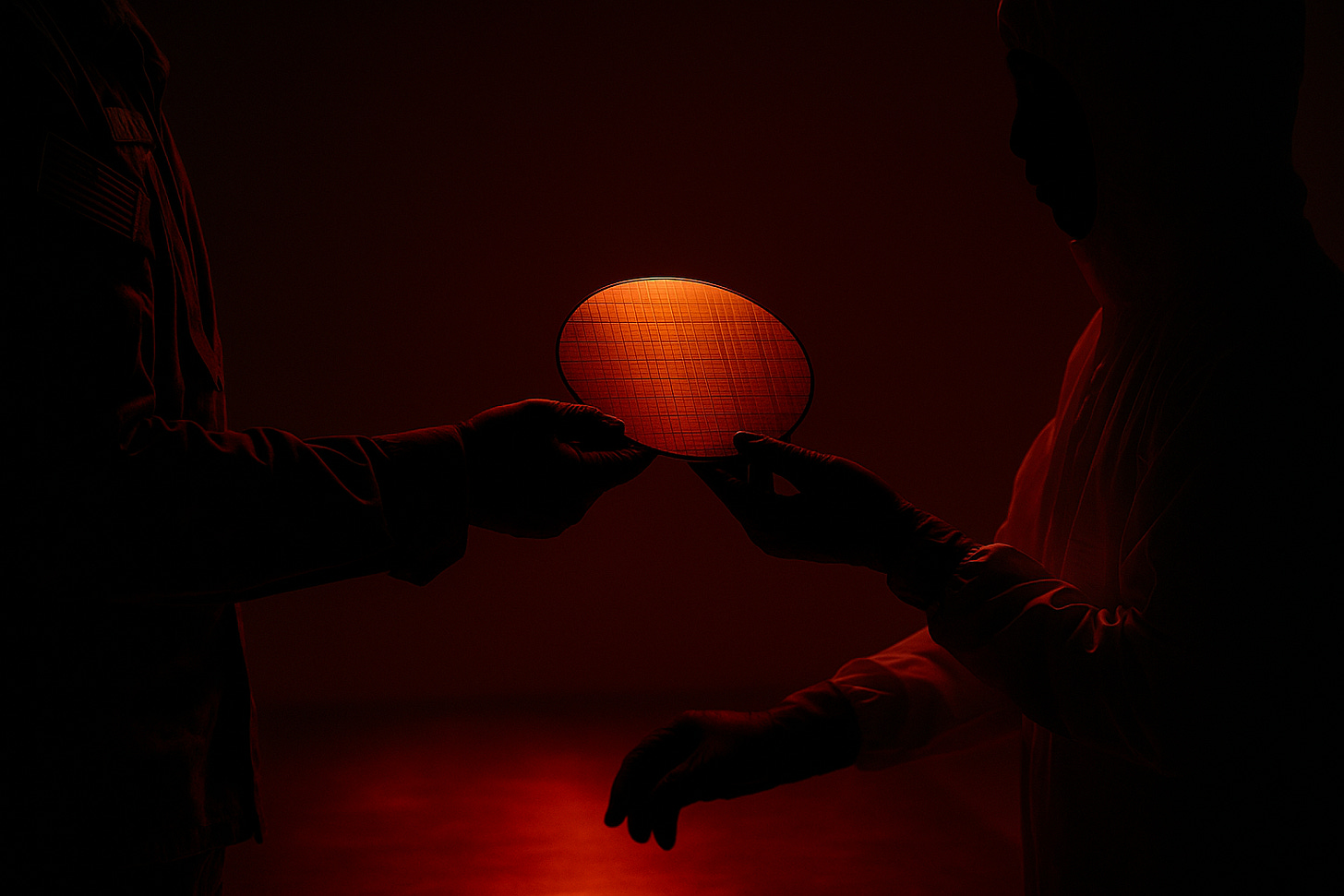EXC: U.S. Army Funded Research At China’s Top Semiconductor Lab Targeting America’s Chip Dominance

While Washington warns of an existential race for semiconductor supremacy, U.S. taxpayer dollars have quietly flowed to the very Chinese state lab leading Beijing’s campaign to overtake America’s chip industry.
At the center of this paradox sits the Institute of Semiconductors (IOS) at the Chinese Academy of Sciences (CAS), which is a core node in the Chinese Communist Party’s plan to achieve “independent and controllable” chip production and surpass the U.S. in advanced materials, optoelectronics, and next-generation computing.
This Substack is reader-supported. To receive new posts and support my work, consider becoming a free or paid subscriber.
IOS is not just another university lab. It is one of Beijing’s flagship national research bases, directly under CAS. CAS is the regime’s top-level science arm run by the State Council. Its mandate aligns perfectly with Xi Jinping’s call to “win the battle for core technologies.”
Within China’s semiconductor strategy, IOS leads work on compound semiconductors, photonics, and quantum optoelectronics. These are the “non-silicon” sectors where Beijing sees its best chance to leapfrog U.S. industry. They’re also the materials that power advanced radar, lasers, 5G base stations, and missile guidance systems.
Chinese state media openly describes IOS as “a critical force in the national drive for semiconductor self-reliance.”
Funded by American Taxpayers
Despite that status, IOS has repeatedly appeared on U.S.-funded research projects, including collaborations supported by the National Science Foundation (NSF), the Office of Naval Research (ONR), and the Department of Energy (DOE).
In some cases, the U.S. Army has even funded the CCP laboratory.
Federal grant databases reveal at least 30 awards citing joint publications or co-authorships with IOS researchers.
The study “A Comparison Study of Canonical Correlation Analysis Based Methods for Detecting Steady-State Visual Evoked Potentials” included researchers from UC San Diego and China’s State Key Laboratory on Integrated Optoelectronics at the Institute of Semiconductors, Chinese Academy of Sciences.
The U.S. Office of Naval Research, Army Research Office, Army Research Laboratory, DARPA, and National Institutes of Health all funded the study.
The study “Evidence for a topological excitonic insulator in InAs/GaSb bilayers” and “Orbital two-channel Kondo effect in epitaxial ferromagnetic L10-MnAl films” funded by DOE and the NSF.
The study “Disorder-induced topological phase transitions in two-dimensional spin-orbit coupled superconductors” was funded by the NSF in addition to “Anomalous resistivity upturn in epitaxial L21-Co2MnAl films” and “Enhancing the Curie Temperature of Ferromagnetic Semiconductor.”
“Magnetic coupling at rare earth ferromagnet/transition metal ferromagnet interfaces” counted funding from the Department of Energy.
Here is a full list of the studies, which can be accessed here:
Analysis of Hippocampus Evolution Patterns and Prediction of Conversion in Mild Cognitive Impairment Using Multivariate Morphometry Statistics
Raman Scattering of Non-Planar Graphite: Arched Edges, Polyhedral Crystals, Whiskers and Cones
Large Band Edge Tunability in Colloidal Nanoplatelets
High-Speed Spelling with a Noninvasive Brain-Computer Interface
Evidence for a Topological Excitonic Insulator in InAs/GaSb Bilayers
Defects Activated Photoluminescence in Two-Dimensional Semiconductors: Interplay Between Bound, Charged, and Free Excitons
Layer-Dependent Electrical and Optoelectronic Responses of ReSe₂ Nanosheet Transistors
Disorder-Induced Topological Phase Transitions in Two-Dimensional Spin-Orbit Coupled Superconductors
Tunable Polarity Behavior and Self-Driven Photoswitching in p-WSe₂/n-WS₂ Heterojunctions
Low-Frequency Shear and Layer-Breathing Modes in Raman Scattering of Two-Dimensional Materials
Modeling of Dielectric Elastomer Oscillators for Soft Biomimetic Applications
Anomalous Resistivity Upturn in Epitaxial L2₁-Co₂MnAl Films
Controlled Synthesis of Phase-Pure InAs Nanowires on Si(111) by Diminishing the Diameter to 10 nm
Near-Infrared Plasmonic-Enhanced Solar Energy Harvest for Highly Efficient Photocatalytic Reactions
Revealing the Origin of Fast Electron Transfer in TiO₂-Based Dye-Sensitized Solar Cells
Orbital Two-Channel Kondo Effect in Epitaxial Ferromagnetic L1₀-MnAl Films
Monolayer Behaviour in Bulk ReS₂ Due to Electronic and Vibrational Decoupling
Anisotropic In-Plane Thermal Conductivity of Black Phosphorus Nanoribbons at Temperatures Higher Than 100 K
Enhancing the Curie Temperature of Ferromagnetic Semiconductor (Ga,Mn)As to 200 K via Nanostructure Engineering
High-Harmonic and Single Attosecond Pulse Generation Using Plasmonic Field Enhancement in Ordered Arrays of Gold Nanoparticles with Chirped Laser Pulses
Uncovering and Tailoring Hidden Rashba Spin-Orbit Splitting in Centrosymmetric Crystals
Quasi-Direct Optical Transitions in Silicon Nanocrystals with Intensity Exceeding the Bulk
Magnetic Coupling at Rare Earth Ferromagnet/Transition Metal Ferromagnet Interfaces: A Comprehensive Study of Gd/Ni
A Comparison Study of Canonical Correlation Analysis Based Methods for Detecting Steady-State Visual Evoked Potentials
Electronic Structural Moiré Pattern Effects on MoS₂/MoSe₂ 2D Heterostructures
Absence of Redshift in the Direct Bandgap of Silicon Nanocrystals with Reduced Size
Evidence for Structural Phase Transitions Induced by the Triple Phase Line Shift in Self-Catalyzed GaAs Nanowires
Design and Synthesis of an Artificial Perpendicular Hard Ferrimagnet with High Thermal and Magnetic Field Stabilities
A Graphene-Based Fabry-Pérot Spectrometer in the Mid-Infrared Region
All Zinc-Blende GaAs/(Ga,Mn)As Core-Shell Nanowires with Ferromagnetic Ordering
China’s rise in semiconductors isn’t an accident.
It’s the product of a deliberate state-driven strategy to control the technologies that decide global power. What my reporting shows is even worse: American tax dollars have quietly helped fuel the very research the CCP relies on to close the gap and tilt the industry in its favor. Beijing treats chip supremacy as a national survival project, and Washington has been sleepwalking into underwriting it.